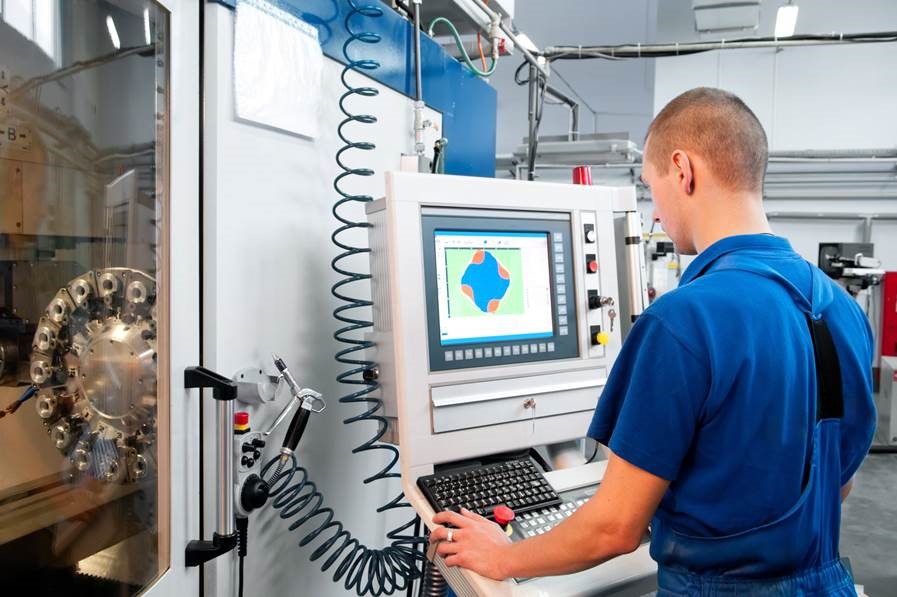By linking production PLCs with PC-based data acquisition and analysis, shops that fabricate customized, complex, tight-tolerance products can exploit the best attributes of each to achieve consistency and quality.
CNC machining benefits from PLC operation linked to PC control, networking
By linking production PLCs with PC-based data acquisition and analysis, shops that fabricate customized, complex, tight-tolerance products can exploit the best attributes of each to achieve consistency and quality.
By Eamonn Walsh, Brainboxes

Advanced CNC machines are enabling the fabrication of intricate, large parts with complexity and tolerances which were not achievable even just a few years ago. Combined with advances in CAD/CAM analysis, planning and machine set-up, these improvements have also created additional and aggressive expectations by designers and fabrication shops. As usual, technological advancement has widened the goal posts of possibility. It’s not unusual for multi-axis machining operations on a single workpiece to require many unattended hours, with each step carefully analyzed, calculated, and choreographed in advance; it’s a world where a single wrong move or mistaken instruction cannot be undone and can ruin an expensive project.
The long-established PLC is a very good fit as the controller for a CNC machine given it can handle the demands of tight tool control and feedback while also functioning amid the harsh environment of the shop floor. Implementing the individual fabrication steps with the tight tolerances and intricate motions to defined precision shapes to precise dimensions is a task well suited to the PLC.
But the PLC is not the appropriate controller for analyzing and preparing the machine’s operation, or for providing the long, carefully timed set of instructions to the CNC machine—a process which may span hours. It is limited in both computation capability and sequencing ability. Furthermore, it is limited in its ability to provide work-in-process updates or production-related data.
PCs working in conjunction with PLCs are the solution for those tasks. With their computational power, PCs can provide the necessary calculation-intensive capabilities for CAD/CAM applications to work out the complex dimensional analysis needed for the various cuts, machining paths, critical angles and their overall production sequencing.
In addition, PCs and their multifaceted networking options can easily link to other PCs to provide Ethernet connectivity and other standard I/O ports. Critically they also support legacy interfaces such as RS-232. Their capabilities go beyond the basic hardware interfaces, as well, as they can support the myriad formats and protocols required by the diverse world of PLC-based CNC machines.
Using PCs for analysis, interfacing, and networking in conjunction with basic PLC control provides other management benefits. They can provide the numerous, increasingly mandated regulatory and traceability reports. Further, with their ubiquitous networking capabilities, they can link multiple test or production stations, factory inventory status, customer information and other production considerations. The result is mass production but combined with a high degree of per-unit customization.
Pulling PLCs and PCs together
The PLC has its well-established role at the production line, while the PC provides higher-level access to an almost unlimited array of application software for advanced data analysis to support production planning, tracking, traceability and scheduling. Adding the considerable resources of PCs and their networks to a PLC test or production system takes advantage of the substantial benefits of each while avoiding their traditional weaknesses (see Sidebar). Using CAD/CAM application tools, the PC can work out machining specifics and then feed the CNC a long sequence of precise instructions—which must often be via a proprietary CNC protocol. The PC also enables further optimization including improved yields, margins, and profits, as well as improved regulatory compliance.
PC-based analysis and connectivity gives management insight into production flow, along with a broad view of the process shifts which affect output, ranging from materials to operational to maintenance issues. As a result, management is better equipped to anticipate problems and deal with them proactively, rather than just being reactive and in “emergency” mode. Management can integrate additional factors including market data, availability and pricing of raw materials, and inventory situation, as part of the ERP (enterprise resource planning) goal.
There’s a hardware benefit as well. By adding data analysis as well as connectivity via the PC and network, management can harness the relentless move of PC/network components along the higher-performance/lower-cost curve. Moreover, it brings flexibility in connecting to, viewing, and querying PC-friendly networks using smartphones and tablets, so the possibilities become dramatic and wide-ranging.
The right modules can bridge the divide
Still, there’s a legitimate concern which can’t be ignored, namely, the legacy issues and need for ongoing compatibility with the installed base of PLCs running CNC machines and their unique I/O. Replacing these is simply not a viable option in existing facilities, nor for new installations. The question often asked is: “how do we integrate the best of these two approaches and add PC-based functionality, still support installed legacy hardware and software as needed, and remain open to the inevitable future requirements?
“Fortunately, there are multilevel approaches which meet the issues of the PLC and PC worlds, along with multiple networking and interoperability concerns, plus legacy factors. In the right combinations, these integrate the vertical path from transducer I/O and its basic interfaces, to factory protocols and advanced network compatibility. They also encompass the broad horizontal span of system-level gateways, databases, development tools, and high-level network access.
A new highly-integrated digital networking module for industrial machine control demonstrates how these advanced building blocks have evolved to bridge the gap between PC and PLC worlds. The ED-204 combines a dual-port Ethernet switch, an Ethernet to RS-232 serial interface and an Ethernet to 4-channel digital I/O in a compact 3-in-1 solution that saves the cost of deploying three separate units.
At the networking and management levels this module can be configured, monitored and controlled using a Windows COM port driver, which enables legacy software support by providing an interface to the Windows platform. Seamlessly networking the older serial modules extends their life for many years to come, keeping costs low and investment return high; plant engineers don’t need to retrain to use these devices. The port is compatible with industry-standard PC packages such as LabView, MATLAB, and Agilent VEE so users can continue to exploit the benefits of their existing development and process-control system.
The module can also deliver data directly to the Android Smartphone, Android Tablet, Apple iPhone and iPad, or indeed any device that has a web browser. System programmers can use the available Application Programming Interfaces (APIs) to integrate functionality into their software platforms. These APIs span a wide range of programming languages: C#, C++, PHP, Perl, JavaScript, Visual Basic and .NET (with more coming).
Further, it’s important to look ahead while not obsoleting the installed base; even the venerable RS-232 interface still has an important place in the PLC/CNC world. That’s why there are adapter modules which provide connectivity and protocol compatibility between well-established serial interface standard and the ubiquitous Ethernet port. This allows the PC-based system to provide operating management and supervision all the way down to the PLC level, if desired.

The road ahead
As PCs increase their role with respect to PLC-based test and production, modules such as Brainboxes’ ED units can support plant managers and manufacturers who stay with PLCs for basic control, but who also want to have access to the system-wide, analysis-focused, and networked advantages which PCs can bring—especially when integrated with PLCs where appropriate. Selecting a module with PC and network interfaces and compatibility allows them to keep their options open for the future.
The momentum is inescapable and a good thing: the current direction of the industrial markets is convergent with the PLC market, shifting to increasing PC-based, high-level involvement. This is a consequence of the pervasiveness of the PC and its associated applications. Whereas PLCs are proprietary systems with so-called ‘open’ standards that actually differ from manufacturer to manufacturer, PCs, with their high-level networks and application packages, fit the needs of advanced insight, broad management, interconnection, and data sharing.
When properly configured and deployed, an architecture which builds on PLC-based test and production, and enhances it with PC power, offers genuine synergy and significant benefits from top to bottom. It allows management to acquire more and better product-test data, then analyze, use, track, report, archive, and retrieve it, all resulting in improved insight and performance.
About the author
Eamonn Walsh is Chairman and Managing Director at Brainboxes. He founded the company in 1984 and has spearheaded the company’s international expansion, working closely with engineering, marketing and sales teams to successfully design, develop and launch many innovative digital I/O products. Eamonn has a Masters degree in Electronics Engineering and Electronics.
For more information, visit www.brainboxes.com
PLCs vs PCs
Claimed advantages of PLCs:
• Simpler, dedicated functionality
• Security
• Robustness: EMI, contamination, vibration
• Familiarity: programming, installation, maintenance
• Real-time, deterministic OS
• Easy integration
• If one fails, others may continue to operate
• Almost instant reboot
• No need for constant software updates
Disadvantages of PLCs:
• Proprietary programming: more to learn across multiple products
• Limited IO options
•Limited processing power: larger number needed for complex plants
• Expensive
Claimed advantages of PCs:
• More diverse and flexible functionality: supervisory, reporting etc.
• More capable HMI
• Not proprietary, either in hardware or software
• Programmable in popular, proven languages: including C, C++ etc.
• Faster, more flexible communications: IEEE 1394, USB, plus serial
• Easy addition of peripherals
• Easy network expansion
Disadvantages of PCs:
• Sometimes less robust (fans, hard disks)
• Vulnerable to virus attacks
• Single point of failure if they control the whole plant
• Need to manage frequent OS updates
• Concerns about long-term OS support
